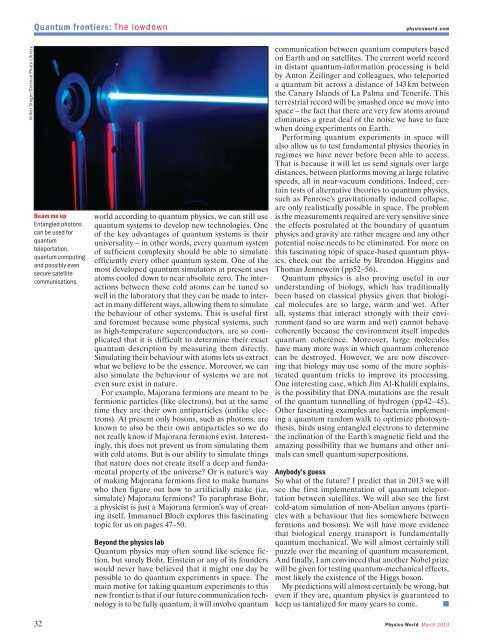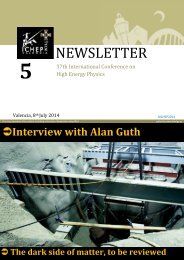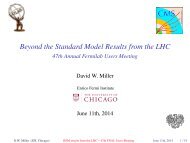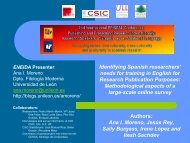PW_mar13_sample_issue
PW_mar13_sample_issue
PW_mar13_sample_issue
Create successful ePaper yourself
Turn your PDF publications into a flip-book with our unique Google optimized e-Paper software.
Volker Steger/Science Photo Library<br />
Quantum frontiers: The lowdown<br />
Beam me up<br />
Entangled photons<br />
can be used for<br />
quantum<br />
teleportation,<br />
quantum computing<br />
and possibly even<br />
secure satellite<br />
communications.<br />
32<br />
world according to quantum physics, we can still use<br />
quantum systems to develop new technologies. One<br />
of the key advantages of quantum systems is their<br />
universality – in other words, every quantum system<br />
of sufficient complexity should be able to simulate<br />
efficiently every other quantum system. One of the<br />
most developed quantum simulators at present uses<br />
atoms cooled down to near absolute zero. The interactions<br />
between these cold atoms can be tuned so<br />
well in the laboratory that they can be made to interact<br />
in many different ways, allowing them to simulate<br />
the behaviour of other systems. This is useful first<br />
and foremost because some physical systems, such<br />
as hightemperature superconductors, are so complicated<br />
that it is difficult to determine their exact<br />
quantum description by measuring them directly.<br />
Simulating their behaviour with atoms lets us extract<br />
what we believe to be the essence. More over, we can<br />
also simulate the behaviour of systems we are not<br />
even sure exist in nature.<br />
For example, Majorana fermions are meant to be<br />
fermionic particles (like electrons), but at the same<br />
time they are their own antiparticles (unlike electrons).<br />
At present only bosons, such as photons, are<br />
known to also be their own antiparticles so we do<br />
not really know if Majorana fermions exist. Interestingly,<br />
this does not prevent us from simulating them<br />
with cold atoms. But is our ability to simulate things<br />
that nature does not create itself a deep and fundamental<br />
property of the universe? Or is nature’s way<br />
of making Majorana fermions first to make humans<br />
who then figure out how to artificially make (i.e.<br />
simulate) Majorana fermions? To paraphrase Bohr,<br />
a physicist is just a Majorana fermion’s way of creating<br />
itself. Immanuel Bloch explores this fascinating<br />
topic for us on pages 47–50.<br />
Beyond the physics lab<br />
Quantum physics may often sound like science fiction,<br />
but surely Bohr, Einstein or any of its founders<br />
would never have believed that it might one day be<br />
possible to do quantum experiments in space. The<br />
main motive for taking quantum experiments to this<br />
new frontier is that if our future communication technology<br />
is to be fully quantum, it will involve quantum<br />
physicsworld.com<br />
communication between quantum computers based<br />
on Earth and on satellites. The current world record<br />
in distant quantuminformation processing is held<br />
by Anton Zeilinger and colleagues, who teleported<br />
a quantum bit across a distance of 143 km between<br />
the Canary Islands of La Palma and Tenerife. This<br />
terrestrial record will be smashed once we move into<br />
space – the fact that there are very few atoms around<br />
eliminates a great deal of the noise we have to face<br />
when doing experiments on Earth.<br />
Performing quantum experiments in space will<br />
also allow us to test fundamental physics theories in<br />
regimes we have never before been able to access.<br />
That is because it will let us send signals over large<br />
distances, between platforms moving at large relative<br />
speeds, all in nearvacuum conditions. Indeed, certain<br />
tests of alternative theories to quantum physics,<br />
such as Penrose’s gravitationally induced collapse,<br />
are only realistically possible in space. The problem<br />
is the measurements required are very sensitive since<br />
the effects postulated at the boundary of quantum<br />
physics and gravity are rather meagre and any other<br />
potential noise needs to be eliminated. For more on<br />
this fascinating topic of spacebased quantum physics,<br />
check out the article by Brendon Higgins and<br />
Thomas Jennewein (pp52–56).<br />
Quantum physics is also proving useful in our<br />
understanding of biology, which has traditionally<br />
been based on classical physics given that biological<br />
mole cules are so large, warm and wet. After<br />
all, systems that interact strongly with their environment<br />
(and so are warm and wet) cannot behave<br />
coherently because the environment itself impedes<br />
quantum coherence. Moreover, large molecules<br />
have many more ways in which quantum coherence<br />
can be destroyed. However, we are now discovering<br />
that biology may use some of the more sophisticated<br />
quantum tricks to improve its processing.<br />
One interesting case, which Jim AlKhalili explains,<br />
is the possibility that DNA mutations are the result<br />
of the quantum tunnelling of hydrogen (pp42–45).<br />
Other fascinating examples are bacteria implementing<br />
a quantum random walk to optimize photosynthesis,<br />
birds using entangled electrons to determine<br />
the inclination of the Earth’s magnetic field and the<br />
amazing possibility that we humans and other animals<br />
can smell quantum superpositions.<br />
Anybody’s guess<br />
So what of the future? I predict that in 2013 we will<br />
see the first implementation of quantum teleportation<br />
between satellites. We will also see the first<br />
coldatom simulation of nonAbelian anyons (particles<br />
with a behaviour that lies somewhere between<br />
fermions and bosons). We will have more evidence<br />
that biological energy transport is fundamentally<br />
quantum mechanical. We will almost certainly still<br />
puzzle over the meaning of quantum measurement.<br />
And finally, I am convinced that another Nobel prize<br />
will be given for testing quantummechanical effects,<br />
most likely the existence of the Higgs boson.<br />
My predictions will almost certainly be wrong, but<br />
even if they are, quantum physics is guaranteed to<br />
keep us tantalized for many years to come. n<br />
Physics World March 2013








